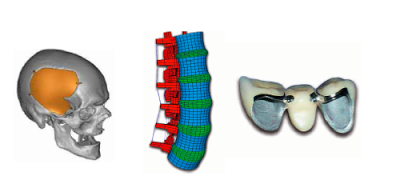“If the federal government created a ‘human organ project’ and wanted to make the kidney, I literally think it could happen in 10 years,” said chemical engineer Keith Murphy, co-founder of Organovo, a firm that makes and works with high-end bioprinters. But that would require a massive commitment of people, resources and billions of dollars.
Implantable fabricatable body parts
Bioprinting technology is years and possibly decades from producing such complex organs, but scientists have already printed skin and vertebral disks (the soft tissue that grows in the spine between the vertebrae) and put them into living bodies. So far, none of those bodies have been human, but a few types of printed replacement parts could be ready for human trials in two to five years.
Once scientists get over the financial and technical hurdles of bioprinting, they will have to square the process with the Food and Drug Administration, which will have to decide how to regulate something that is not simply a device, a biological product or a drug, but potentially all three.
Before printed organs are implanted into people, bioprinting may be used in other ways. Murphy’s group is working on a project that will replicate tissue for testing the effects of medications, particularly cancer drugs. This could eliminate some of the drawn-out, trial-and-error process of trying a series of drugs on a person before finding one that works.
A patient specific titanium skull implant made with 3D printing using the Direct Metal Laser Sintering technology by EOS. Several thousand patients worldwide currently have 3D printed titanium implants in their hips, skulls or legs. In addition a total of 100,000 people have been helped with patient specific surgical guides that are 3D printed. Also, 10,000,000 people worldwide are currently wearing 3D printed hearing aids.
If one can bioprint functional human organ constructs, then bioprinting a whole human — or whatever will be the name for such a creature — is just a logical extension,” said Vladimir Mironov, a pioneer in the field who is working with computer companies to design better bioprinting software.
Some do not now why anyone would do that. However, I do. Being able to bioprint a whole body would allow for brain transplant whole body rejuvenation. The brain could also be rejuvenated with stem cells.
If you liked this article, please give it a quick review on ycombinator or StumbleUpon. Thanks

Brian Wang is a Futurist Thought Leader and a popular Science blogger with 1 million readers per month. His blog Nextbigfuture.com is ranked #1 Science News Blog. It covers many disruptive technology and trends including Space, Robotics, Artificial Intelligence, Medicine, Anti-aging Biotechnology, and Nanotechnology.
Known for identifying cutting edge technologies, he is currently a Co-Founder of a startup and fundraiser for high potential early-stage companies. He is the Head of Research for Allocations for deep technology investments and an Angel Investor at Space Angels.
A frequent speaker at corporations, he has been a TEDx speaker, a Singularity University speaker and guest at numerous interviews for radio and podcasts. He is open to public speaking and advising engagements.



